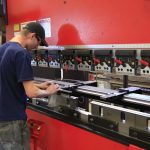 By Lucas H. Parker
By Lucas H. Parker
The toughest part of running a business is getting it off the ground. Small businesses and startups have a lot of ground to cover before they can expand and increase their reach. Getting the right equipment is a huge hurdle for many small businesses.
The issue is that the initial capital to buy the equipment just isn’t there yet. This is why up and coming businesses often look into financing options for their equipment. It’s a worthwhile investment. Here’s how successful small businesses handle equipment financing.
– Make a list of your business’s needs
Before you can actually settle on a financial plan for equipment, you need to roughly estimate what equipment you need. Create a list of your equipment needs and start from there. This will give you an idea of what to aim for with your payment plan.
Consider the cost and useful life of the equipment you intend to purchase. This is the accepted standard for how long a piece of equipment could be expected to stay in service. This is especially important for the loans your business might want to take out for the equipment. You don’t want to keep paying for the loan long after the equipment has lost its function.
– Have some spare funds on hand
There are a couple of things you need to consider before choosing your equipment financing option. Many of them don’t cover the entirety of the cost of equipment. This means your business is going to have to cover the rest. Usually, various lenders will agree to around eighty or ninety percent of the cost of the equipment.
How you decide to finance the last ten percent is up to you and your business. It’s not a humongous cost compared to the original price of the equipment, but it’s something many small businesses might struggle with. It’s important that you have some extra funds prepare for this kind of investment before you decide on a financing option. It’s going to help you better decide what option to go with later on.
– Finance specialized equipment
Many small businesses will require some specialized equipment for regular day-to-day work. This equipment is often a lot more expensive than more common counterparts. Luckily, there are some pretty favorable finance options that help businesses acquire this type of equipment.
Specialized equipment options are repayable on fixed terms. These terms can range from one year to up to five years. Interest rates tend to be around seven or eight percent. These payment options closely resemble term loans. As collateral, the lender uses the equipment itself. It’s a pretty safe bet, considering this equipment is often essential to the business. This incentivizes them to pay on time so that they don’t lose the equipment.
– Determine financing options
Businesses can choose from a wide variety of equipment loan options. Each option has its own benefits and drawbacks. Traditional banks are one example. They generally give loans based on a business’s cash flow. This is a great option for well-established businesses that have a steady cash flow. However, small businesses are at a disadvantage. They don’t normally have much of a financial history and their current revenues aren’t deemed enough.
Small business administrations are another great financing option. They’re a bit different compared to other asset finance solutions. Instead of providing the loan themselves, these administrations provide financing options indirectly. They provide guarantees to lenders which then give loans to the business. The small business administration evaluates a business and figures out whether or not it’s worth supporting. They come with some very competitive rates terms, which makes them ideal for many small businesses and startups.
– Alternative options
Official lenders aren’t the only sources of financing that you can use to get equipment funds. You can also look into alternative options. These include things like peer-to-peer lending. In many cases, alternative options don’t directly fund equipment. Instead, working capital needs of the business are funded. Since they’re cash-flow lenders, the loan depends entirely on weekly and daily receipts.
Alternative sources of funding are much more accessible to the average business. It’s pretty easy for a business to qualify and the processing times are short. These loans generally don’t exceed a hundred thousand dollars. They’re great for small projects and startup ideas, but larger businesses don’t have much use of them. Not to mention, they come with some hefty drawbacks as well. For one, the terms are usually short and they have large interest. Repayment plans might include daily or weekly repayments, which can further stress a small business. Due to the aggressive terms that some alternative financing options have, they are discouraged for any business that is on shaky ground.
Conclusion
If your business is in need of equipment, you need to find a reasonable way to acquire it. Some of these financing options are good for smaller businesses, while others are better suited for a well-established business. It’s important that you find the right option for your own business so that work can begin and you can start creating more capital.
_________
Lucas H. Parker is a business consultant and editor in chief at savingforserenity.com. Besides that, he has a passion for writing. Doing his research, exploring and writing are his favorite things to do. Besides that, he loves playing his guitar, hiking, and travelling.
